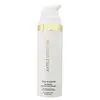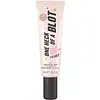What's inside
What's inside
 Key Ingredients
Key Ingredients

 Benefits
Benefits

 Concerns
Concerns

 Ingredients Side-by-side
Ingredients Side-by-side

Water
Skin ConditioningIsodecyl Neopentanoate
EmollientGlycerin
HumectantTalc
AbrasiveOctyldodecanol
EmollientDimethicone
EmollientGlyceryl Stearate Citrate
EmollientHydroxyethyl Acrylate/Sodium Acryloyldimethyl Taurate Copolymer
Emulsion StabilisingMica
Cosmetic ColorantPhenoxyethanol
PreservativePolyacrylate-21
Dimethicone/Vinyl Dimethicone Crosspolymer
Skin ConditioningGlyceryl Stearate
EmollientSodium Polyacrylate
AbsorbentCaramel
Cosmetic ColorantEthylhexylglycerin
Skin ConditioningTocopheryl Acetate
AntioxidantChlorphenesin
AntimicrobialSodium Hydroxide
BufferingSqualane
EmollientSilica
AbrasiveAllantoin
Skin ConditioningCamellia Oleifera Seed Oil
Skin ConditioningPolysorbate 60
EmulsifyingSodium Acrylates Copolymer
Sorbitan Isostearate
EmulsifyingButylene Glycol
HumectantCaprylyl Glycol
EmollientLecithin
EmollientNiacinamide
SmoothingDipropylene Glycol
HumectantCitrus Grandis Peel Oil
MaskingGlyceryl Caprylate
EmollientSodium Hyaluronate
HumectantHydrolyzed Algin
Solanum Lycopersicum Leaf Cell Culture Extract
Skin ConditioningLimonene
PerfumingTin Oxide
AbrasiveCI 77891
Cosmetic ColorantCI 77491
Cosmetic ColorantWater, Isodecyl Neopentanoate, Glycerin, Talc, Octyldodecanol, Dimethicone, Glyceryl Stearate Citrate, Hydroxyethyl Acrylate/Sodium Acryloyldimethyl Taurate Copolymer, Mica, Phenoxyethanol, Polyacrylate-21, Dimethicone/Vinyl Dimethicone Crosspolymer, Glyceryl Stearate, Sodium Polyacrylate, Caramel, Ethylhexylglycerin, Tocopheryl Acetate, Chlorphenesin, Sodium Hydroxide, Squalane, Silica, Allantoin, Camellia Oleifera Seed Oil, Polysorbate 60, Sodium Acrylates Copolymer, Sorbitan Isostearate, Butylene Glycol, Caprylyl Glycol, Lecithin, Niacinamide, Dipropylene Glycol, Citrus Grandis Peel Oil, Glyceryl Caprylate, Sodium Hyaluronate, Hydrolyzed Algin, Solanum Lycopersicum Leaf Cell Culture Extract, Limonene, Tin Oxide, CI 77891, CI 77491
Water
Skin ConditioningGlycerin
HumectantDimethicone
EmollientPentaerythrityl Tetrabehenate
EmollientButylene Glycol
HumectantMethyl Methacrylate Crosspolymer
Oryza Sativa Starch
AbsorbentHydroxyethyl Acrylate/Sodium Acryloyldimethyl Taurate Copolymer
Emulsion StabilisingSodium Acrylate/Sodium Acryloyldimethyl Taurate Copolymer
Emulsion StabilisingPhenoxyethanol
PreservativePolysilicone-11
Acrylates/C10-30 Alkyl Acrylate Crosspolymer
Emulsion StabilisingIsohexadecane
EmollientEnantia Chlorantha Bark Extract
Skin ConditioningEthylhexylglycerin
Skin ConditioningChlorphenesin
AntimicrobialSodium Hydroxide
BufferingDisodium EDTA
Polysorbate 80
EmulsifyingSodium Hyaluronate
HumectantTocopheryl Acetate
AntioxidantCaramel
Cosmetic ColorantSorbitan Oleate
EmulsifyingPolysorbate 60
EmulsifyingSorbitan Isostearate
EmulsifyingOleanolic Acid
Skin ConditioningCI 16035
Cosmetic ColorantWater, Glycerin, Dimethicone, Pentaerythrityl Tetrabehenate, Butylene Glycol, Methyl Methacrylate Crosspolymer, Oryza Sativa Starch, Hydroxyethyl Acrylate/Sodium Acryloyldimethyl Taurate Copolymer, Sodium Acrylate/Sodium Acryloyldimethyl Taurate Copolymer, Phenoxyethanol, Polysilicone-11, Acrylates/C10-30 Alkyl Acrylate Crosspolymer, Isohexadecane, Enantia Chlorantha Bark Extract, Ethylhexylglycerin, Chlorphenesin, Sodium Hydroxide, Disodium EDTA, Polysorbate 80, Sodium Hyaluronate, Tocopheryl Acetate, Caramel, Sorbitan Oleate, Polysorbate 60, Sorbitan Isostearate, Oleanolic Acid, CI 16035
Ingredients Explained
These ingredients are found in both products.
Ingredients higher up in an ingredient list are typically present in a larger amount.
Butylene Glycol (or BG) is used within cosmetic products for a few different reasons:
Overall, Butylene Glycol is a safe and well-rounded ingredient that works well with other ingredients.
Though this ingredient works well with most skin types, some people with sensitive skin may experience a reaction such as allergic rashes, closed comedones, or itchiness.
Learn more about Butylene GlycolWe don't have a description for Caramel yet.
Chlorphenesin is a synthetic preservative. It helps protect a product against bacteria in order to extend shelf life. In most cases, Chlorphenesin is paired with other preservatives such as phenoxyethanol and caprylyl glycol.
Chlorphenesin is a biocide. This means it is able to help fight the microorganisms on our skin. It is also able to fight odor-releasing bacteria.
Chlorphenesin is soluble in both water and glycerin.
Studies show Chlorphenesin is easily absorbed by our skin. You should speak with a skincare professional if you have concerns about using Chlorphenesin.
Learn more about ChlorphenesinDimethicone is a type of synthetic silicone created from natural materials such as quartz.
What it does:
Dimethicone comes in different viscosities:
Depending on the viscosity, dimethicone has different properties.
Ingredients lists don't always show which type is used, so we recommend reaching out to the brand if you have questions about the viscosity.
This ingredient is unlikely to cause irritation because it does not get absorbed into skin. However, people with silicone allergies should be careful about using this ingredient.
Note: Dimethicone may contribute to pilling. This is because it is not oil or water soluble, so pilling may occur when layered with products. When mixed with heavy oils in a formula, the outcome is also quite greasy.
Learn more about DimethiconeEthylhexylglycerin (we can't pronounce this either) is commonly used as a preservative and skin softener. It is derived from glyceryl.
You might see Ethylhexylglycerin often paired with other preservatives such as phenoxyethanol. Ethylhexylglycerin has been found to increase the effectiveness of these other preservatives.
Glycerin is already naturally found in your skin. It helps moisturize and protect your skin.
A study from 2016 found glycerin to be more effective as a humectant than AHAs and hyaluronic acid.
As a humectant, it helps the skin stay hydrated by pulling moisture to your skin. The low molecular weight of glycerin allows it to pull moisture into the deeper layers of your skin.
Hydrated skin improves your skin barrier; Your skin barrier helps protect against irritants and bacteria.
Glycerin has also been found to have antimicrobial and antiviral properties. Due to these properties, glycerin is often used in wound and burn treatments.
In cosmetics, glycerin is usually derived from plants such as soybean or palm. However, it can also be sourced from animals, such as tallow or animal fat.
This ingredient is organic, colorless, odorless, and non-toxic.
Glycerin is the name for this ingredient in American English. British English uses Glycerol/Glycerine.
Learn more about GlycerinThis is a synthetic polymer. It helps improve the texture of products by adding thickness and gel-like feel.
It is also an emulsifer, meaning it prevents ingredients such as oil and water from separating. It also helps evenly disperse other ingredients.
Phenoxyethanol is a preservative that has germicide, antimicrobial, and aromatic properties. Studies show that phenoxyethanol can prevent microbial growth. By itself, it has a scent that is similar to that of a rose.
It's often used in formulations along with Caprylyl Glycol to preserve the shelf life of products.
Polysorbate 60 is used to help stabilize products. It is a surfactant and emulsifier. These properties help keep ingredients together in a product. Surfactants help reduce surface tension between ingredients with different states, such as liquids and solids. Emulsifiers help prevent oils and waters from separating.
Polysorbate 60 is sorbitol-based and created from the ethoxylation of sorbitan. Ethoxylation is a chemical reaction used to add ethylene oxide. Sorbitan is a the dehydrated version of sorbitol, a sugar found in fruits.
In this case, the 60 comes from reacting 60 units of ethylene oxide with sorbitan.
Polysorbates are commonly used in medicine and foods.
Learn more about Polysorbate 60Sodium Hyaluronate is hyaluronic acid's salt form. It is commonly derived from the sodium salt of hyaluronic acid.
Like hyaluronic acid, it is great at holding water and acts as a humectant. This makes it a great skin hydrating ingredient.
Sodium Hyaluronate is naturally occurring in our bodies and is mostly found in eye fluid and joints.
These are some other common types of Hyaluronic Acid:
Learn more about Sodium HyaluronateSodium Hydroxide is also known as lye or caustic soda. It is used to adjust the pH of products; many ingredients require a specific pH to be effective.
In small amounts, sodium hydroxide is considered safe to use. However, large amounts may cause chemical burns due to its high alkaline.
Your skin has a natural pH and acid mantle. This acid mantle helps prevent harmful bacteria from breaking through. The acid mantle also helps keep your skin hydrated.
"Alkaline" refers to a high pH level. A low pH level would be considered acidic.
Learn more about Sodium HydroxideSorbitan Isostearate is an emulsifer and cleaning agent. It is created from isostearic acid and sorbitol.
As an emulsifier, Sorbitan Isostearate prevents oils and water from separating.
Due to its isostearic acid base, it may not be safe for Malassezia or fungal acne.
Learn more about Sorbitan IsostearateTocopheryl Acetate is AKA Vitamin E. It is an antioxidant and protects your skin from free radicals. Free radicals damage the skin by breaking down collagen.
One study found using Tocopheryl Acetate with Vitamin C decreased the number of sunburned cells.
Tocopheryl Acetate is commonly found in both skincare and dietary supplements.
Learn more about Tocopheryl AcetateWater. It's the most common cosmetic ingredient of all. You'll usually see it at the top of ingredient lists, meaning that it makes up the largest part of the product.
So why is it so popular? Water most often acts as a solvent - this means that it helps dissolve other ingredients into the formulation.
You'll also recognize water as that liquid we all need to stay alive. If you see this, drink a glass of water. Stay hydrated!
Learn more about Water